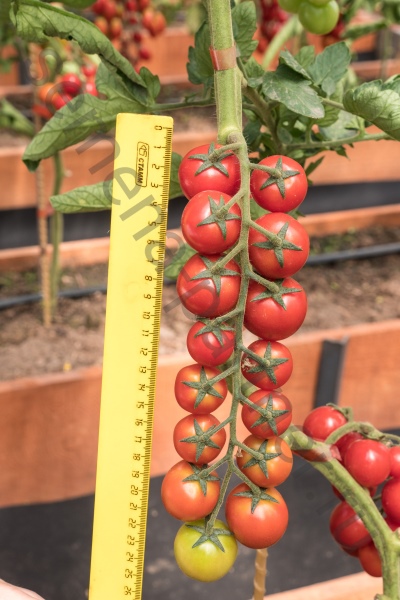
- Category: hybrid
- Growth type: indeterminate
- Appointment: fresh consumption, for pickling and preserving
- Ripening period: early
- Ripening time, days: 95
- Growing conditions: for closed ground
- Marketability: high
- Transportability: Yes
- Bush size: tall
- Bush height, cm: up to 200
Along with the classic types of tomatoes, many summer residents dream of tomatoes that can be used to decorate the garden. Most often, gardeners prefer cherry varieties that are not only tasty, but also aesthetically attractive. These include the new early ripe tomato Cherry Luba.
Breeding history
Cherry Lyuba is a novelty created by a group of Russian breeders whose task was to develop a variety with good stress and disease resistance. Tomatoes appeared on the market in 2016. However, the culture has not yet been entered into the State Register of Breeding Achievements of the Russian Federation. Despite its "youth", the hybrid variety managed to attract the attention of gardeners and farmers. It is recommended to grow tomatoes in greenhouse conditions, but cherry blossoms are also productive in the garden in the southern strip.
Description of the variety
Cherry Luba is a tall shrub of an indeterminate type. The plant is stretched to a height of 200 cm. It is characterized by a weak thickening of green foliage, a strong central trunk with an edge, a deeply branched root system that saturates the plant with nutrients, and simple inflorescences. The first cluster with fruits is formed above the 9th leaf. 15-20 berries are formed in each fruit cluster. The length of the brush reaches 20-25 cm.
It belongs to the universal variety, so tomatoes are eaten fresh, used in cooking, decorating dishes, processed into dressings and drinks, canned whole, pickled.
During the growing period, tomato bushes need to be formed into 1-2 stems, pinned, if necessary, thin out the lower foliage, and also tie up to powerful supports.
The main qualities of the fruit
Mini tomatoes represent a class of small-fruited nightshades. The average weight of a berry is 30 grams, and a whole brush is 350-450 g. Externally, tomatoes resemble rounded balls of regular shape with a perfectly smooth surface. Ripe cherries are evenly covered with a dense red color, and at the stage of technical maturity, the berries are light green in color. The skin of the berries is not thin, but very firm, not felt when eaten. Mini tomatoes grow almost the same in shape and size.
Tomatoes are resistant to cracking, are well transported in boxes and can be stored for a long time without losing their taste and market appeal.
Taste characteristics
Cherry tastes delicious despite being a hybrid. The flesh of the berry is fleshy, tender, juicy, with a dense texture and a low content of seeds. The taste is dominated by sweetness, harmoniously combined with light sourness and fragrant aroma.
Ripening and fruiting
Cherry Luba is an early tomato variety. From the mass appearance of sprouts to ripe tomatoes on fruit clusters, only 95 days pass. The variety has an extended period of fruit production, which allows ripe berries to be removed until early autumn. The active fruiting phase occurs in July and can last until mid-September.
Yield
The crop yield is high and stable. Subject to all the rules of agricultural technology per 1 m2, you can grow up to 12-15 kg of sweet tomatoes.
The timing of planting seedlings and planting in the ground
In late March - early April, seeds are sown, which are sorted and disinfected before that.For fast and friendly germination, it is recommended to provide a greenhouse effect using cling film or glass. With the appearance of 2-3 leaves on the bushes, a picking (seating) can be carried out. In order for the bushes to quickly adapt to new growing conditions, they are pre-hardened for two weeks.
Seedlings are transplanted at the age of 55-60 days. By this time, the bushes should have 5-7 leaves and one flower cluster. Disembarkation is carried out at the end of May.

Growing tomato seedlings is an extremely important process, because it largely depends on whether the gardener will be able to harvest at all. All aspects must be taken into account, from seedbed preparation to planting in the ground.
Landing scheme
Their growth, development and fruiting depend on how correctly tomato bushes are planted on the site. It is recommended to place 3-4 plants per 1 m2, if bushes are kept in 1 trunk. If in 2 stems, then no more than 2 bushes. The optimal layout for planting is 40x60 cm.

Growing and care
The culture is absolutely unpretentious in agricultural technology, but there are some requirements for the soil. The soil should be light, fertile, breathable and free of weeds. The best predecessors on the site are zucchini, cabbage and radishes.
Comprehensive tomato care includes watering, feeding, shaping and tying bushes, removing stepchildren, loosening and weeding the soil, ventilating the greenhouse, and protecting against viruses.




A plant needs different micronutrients at each stage of growth. All fertilizers can be divided into two groups: mineral and organic. Folk remedies are often used: iodine, yeast, bird droppings, eggshells.
It is important to observe the rate and period of feeding. This also applies to folk remedies and organic fertilizers.
Disease and pest resistance
This species is genetically resistant to a number of diseases - tobacco mosaic virus, fusarium wilt, and apical rot. Late blight tomatoes are rarely affected, since they often manage to give the main crop before it arrives.


Resistant to adverse weather conditions
Due to their resistance to stress, vegetables can withstand temperature fluctuations, drought, heat and short cold snaps. Shade and drafts are undesirable for the plant.

























































































